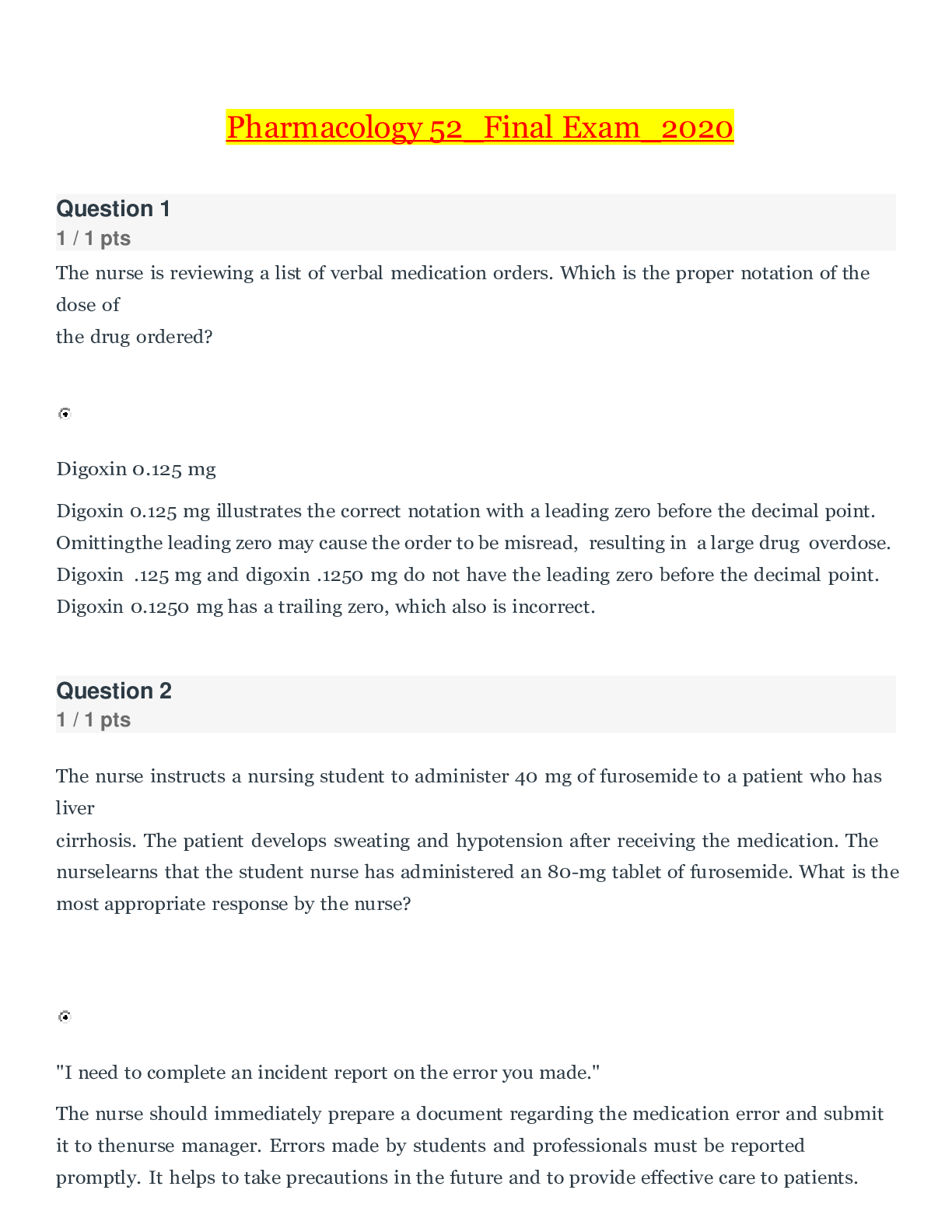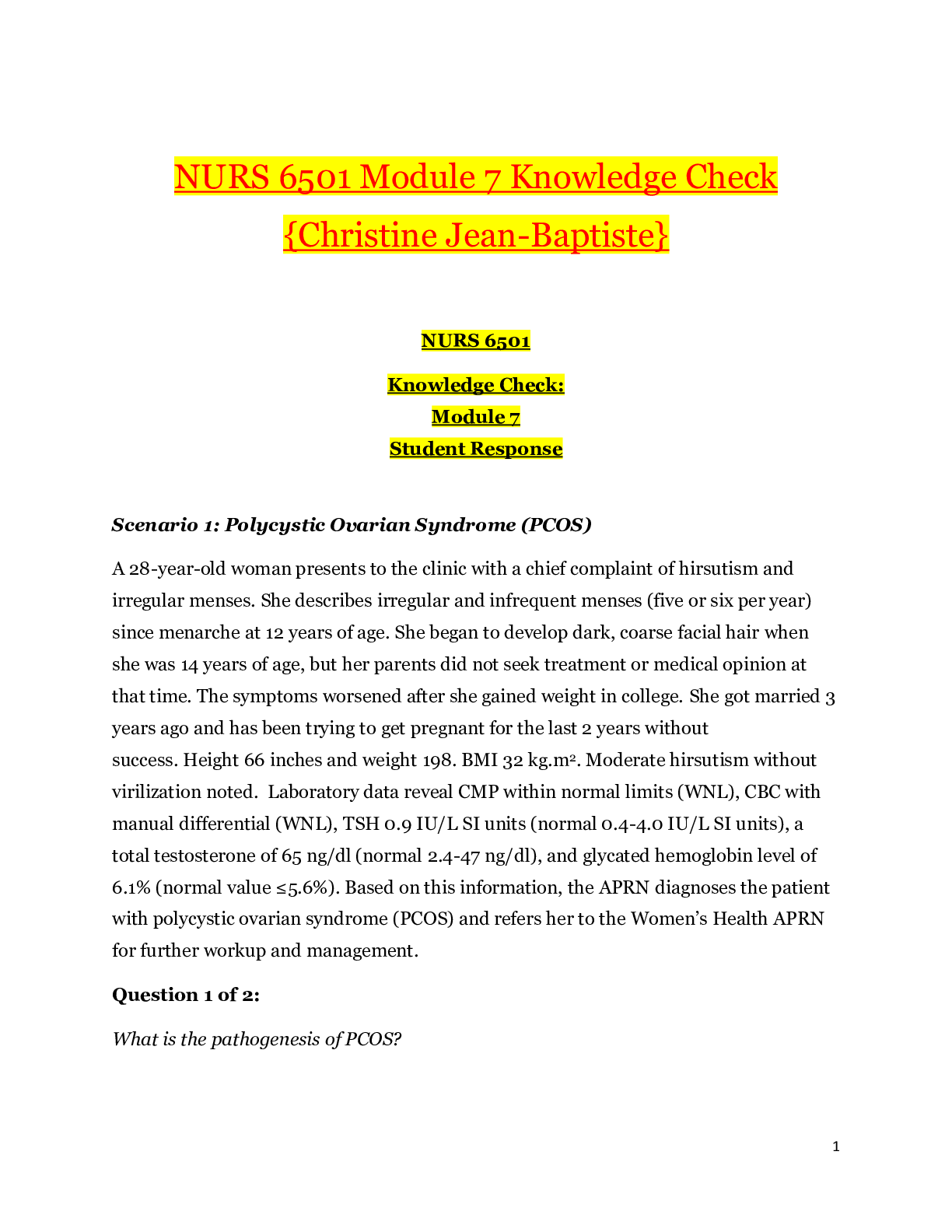Pharmacology > EXAM > Pharmacology 52_Final Exam_2020 | Pharmacology 52_Final Exam_Graded A (All)
Pharmacology 52_Final Exam_2020 | Pharmacology 52_Final Exam_Graded A
Document Content and Description Below
Pharmacology 52_Final Exam_2020 The nurse is reviewing a list of verbal medication orders. Which is the proper notation of the dose of the drug ordered? Digoxin 0.125 mg Digoxin 0.125 mg ... illustrates the correct notation with a leading zero before the decimal point. Omitting the leading zero may cause the order to be misread, resulting in a large drug overdose. Digoxin .125 mg and digoxin .1250 mg do not have the leading zero before the decimal point. Digoxin 0.1250 mg has a trailing zero, which also is incorrect. The nurse instructs a nursing student to administer 40 mg of furosemide to a patient who has liver cirrhosis. The patient develops sweating and hypotension after receiving the medication. The nurse learns that the student nurse has administered an 80mg tablet of furosemide. What is the most appropriate response by the nurse? "I need to complete an incident report on the error you made." The nurse should immediately prepare a document regarding the medication error and submit it to the nurse manager. Errors made by students and professionals must be reported promptly. It helps to take precautions in the future and to provide effective care to patients. The nurse should report all medication errors regardless of the severity. The student nurse may be depressed because of the error. The student nurse must not be excused for the medication error. Advising students immediately regarding their responsibility and the necessity of being cautious can make them feel criticized and helpless. A patient is receiving gabapentin (Neurontin), an anticonvulsant, but has no history of seizures. The nurse expects that the patient is receiving this drug for which condition? Pain associated with peripheral neuropathy Anticonvulsants are often used as adjuvants for treatment of neuropathic pain to enhance analgesic efficacy. The other indications listed are not correct. Question 4 1 / 1 pts A patient is prescribed highdose acetaminophen for longterm treatment of pain. Which medicine may be part of the patient’s treatment plan to prevent complications associated with acetaminophen toxicity? Acetylcysteine Acetaminophen is a nonopioid drug. Higher doses of acetaminophen may increase the risk for acute hepatotoxicity and liver damage. Liver damage from acetaminophen may be minimized by timely dosage of acetylcysteine. Therefore, acetylcysteine should be involved in the patient’s treatment plan to prevent complications associated with acetaminophen. Naloxone is an opioid antagonist used for the treatment of opioid toxicity. Nalbuphine is an opioid agonistantagonist. Naltrexone hydrochloride is an opioid antagonist used in the treatment of opioid toxicity. Immediate postoperative assessment of a patient reveals a body temperature of 102° F. Which action should the nurse perform? Correct Answer Notify the prescriber immediately. A fever immediately postoperatively must be evaluated for potential malignant hyperthermia, which is a medical emergency. Infection of a surgical wound takes several days to develop. A patient is brought to the emergency department for treatment of a suspected overdose. The patient was found with an empty prescription bottle of a barbiturate by his bedside. He is lethargic and barely breathing. The nurse would expect which immediate intervention? Implementing measures to maintain the airway and support respirations There are no antagonists/antidotes for barbiturates. Treatment supports respirations and maintains the airway. The other interventions are not appropriate. A patient of Hispanic origin who experiences insomnia visits the community nurse for counseling. The nurse educates the patient about selfcare activities that may enhance sleep. Which statement indicates the need for additional teaching? "I will have a glass of warm milk before bed." Hispanics, Asians, Pacific Islanders, and African Americans have a high incidence of lactose intolerance. Such patients should not be advised to drink warm milk at bedtime to enhance sleep. Consumption of milk may lead to gastrointestinal distress, abdominal cramping, and bloating. However, lactosefree milk may be used. Exercising just before going to bed may hamper sleep. The primary health care provider may prescribe a mild sedative, if required. Coffee is a stimulant and its consumption must be stopped at least 6 hours before sleep. A patient has experienced insomnia for months, and the physician has prescribed a medication to help with this problem. The nurse expects which drug to be used for longterm treatment of insomnia? Eszopiclone (Lunesta), a nonbenzodiazepine sleep aid Eszopiclone (Lunesta) is one of the newest prescription hypnotics to be approved for longterm use in treatment of insomnia. Barbiturates and benzodiazepines are not appropriate for longterm treatment of insomnia; midazolam is used for procedural (moderate) sedation. A patient who started taking orlistat (Xenical) 1 month ago calls the clinic to report some “embarrassing” adverse effects. She tells the nurse that she has had episodes of “not being able to control my bowel movements.” Which statement is true about this situation? Correct Answer The patient will need to restrict fat intake to less than 30% to help reduce these adverse effects. Restricting dietary intake of fat to less than 30% of total calories can help reduce some of the GI adverse effects, which include oily spotting, flatulence, and fecal incontinence. The other options are incorrect. The nurse prepares to collect the health history of a patient with narcolepsy. Which strategy should be used to complete this assessment? . Correct Answer Use short, focused interview sessions with active participation by the patient. A patient with narcolepsy will be drowsy or fall asleep easily. To obtain accurate information, the nurse should keep the dialogue short and focused. Narcolepsy is an incurable neurologic condition in which patients unexpectedly fall asleep in the middle of normal daily activities. For this reason, it is difficult for patients to complete a structured form. Seeking information from significant others may not always work. Using the patient's past medical information may be helpful, but few critical factors may be missed if the patient is not interviewed. [Show More]
Last updated: 2 years ago
Preview 1 out of 47 pages

Buy this document to get the full access instantly
Instant Download Access after purchase
Buy NowInstant download
We Accept:

Reviews( 0 )
$14.50
Can't find what you want? Try our AI powered Search
Document information
Connected school, study & course
About the document
Uploaded On
Apr 23, 2021
Number of pages
47
Written in
Additional information
This document has been written for:
Uploaded
Apr 23, 2021
Downloads
0
Views
41

.png)













